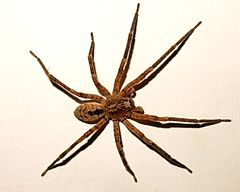Zoropsis spinimana
| Zoropsis spinimana | |
|---|---|
 |
|
| Scientific classification | |
| Kingdom: | Animalia |
| Phylum: | Arthropoda |
| Subphylum: | Chelicerata |
| Class: | Arachnida |
| Order: | Araneae |
| Infraorder: | Araneomorphae |
| Family: | Zoropsidae |
| Genus: | Zoropsis |
| Species: | Z. spinimana |
| Binomial name | |
|
Zoropsis spinimana (Dufour, 1820) |
|
Zoropsis spinimana is a spider species, belonging to the family Zoropsidae.
It is distributed widely in the Mediterranean, but reaches into Russia, and was introduced to the United States, primarily in the San Francisco Bay Area.
Males of the spider species Zoropsis spinimana reach a length of about 10–12 millimetres (0.39–0.47 in), while females are 15–18 millimetres (0.59–0.71 in) long. This spider looks rather like a wolf spider as its eyes are of the same configuration, but unlike wolf spiders, the eyes of Zoropsis spiders are more spread out along the front third of the cephalothorax. The front body (prosoma) is brownish with broad darker markings. The abdomen (opisthosoma) has median black markings. The legs are mainly a speckled brown color.
Spiders of the species can be found on forest edges under rocks and tree bark, where they hunt for prey during the night. Like all zoropsid spiders, Zoropsis spinimana does not build a web but hunts freely. Since this spider cannot survive in a harsh climate, it often seeks refuge in human habituation and is frequently found in houses where the temperature is milder for it and the food is more abundant.
Spiders of the species Zoropsis spinimana are sexually mature in autumn. The females lay eggs in spring, resting in a brood chamber on the cocoon.
...
Wikipedia
